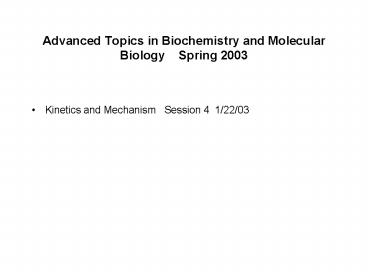Advanced Topics in Biochemistry and Molecular Biology Spring 2003 - PowerPoint PPT Presentation
1 / 15
Title:
Advanced Topics in Biochemistry and Molecular Biology Spring 2003
Description:
Advanced Topics in Biochemistry and Molecular Biology Spring 2003 ... kapp is the rate constant for the ... indomethacin, flurbiprofen, Celebrex,Vioxx ... – PowerPoint PPT presentation
Number of Views:87
Avg rating:3.0/5.0
Title: Advanced Topics in Biochemistry and Molecular Biology Spring 2003
1
Advanced Topics in Biochemistry and Molecular
Biology Spring 2003
- Kinetics and Mechanism Session 4 1/22/03
2
kapp (or k) for first order reactions and kapp
vs Bo plots
- -kapp is the rate constant for the transition
from the chemical state at t 0 to that at t 8
under the particular initial reactant
concentrations chosen - - equilibrium approached from both sides
3
Exploring enzyme inhibitors
- Back to basics.. Michaelis-Menten kinetics
4
Reversible competitive inhibitor
5
Effect of preincubation time on reversible
competitive inhibitor e.g., ibuprofen and
cyclooxygenase (cox) activity of PGH synthase-1
or 2
- rapid initial inhibition, proportional to I
- preincubation with I makes no difference
6
Some inhibitors behave very differently when
preincubated with enzyme e.g., aspirin and
cyclooxygenase (cox) activity of PGH synthase-1
or 2
- Two aspects to such inhibition
- instantaneous (t 0) inhibition
- proportional to I
- fast reversible I binding
- competing with S
- inhibition during preincubation
- increases with time
- first order process
- rate increases with I
7
Accounting for progressive inhibition during
preincubation
- k (or kapp) is a saturable function of aspirin
- reminiscent of saturable binding of ligand ( E
I ? EI ) - suggests a first order process beginning with EI
complex ( EI gt X ) - need to modify competitive inhibition mechanism
8
Modifying competitive inhibitor mechanism
- Two aspects to inhibition by inhibitor such as
aspirin - initial rapid reversible binding to form EI
- slower, irreversible conversion of EI to EI2
- examine the case of reversible second stage later
- Second step behaves like slow, very tight binding
- Such inhibitors called slow-binding or
time-dependent inhibitors - slow here refers to process requiring several
seconds or minutes
9
Slow-binding (time-dependent) inhibitors
- Slow-binding inhibitors not restricted to aspirin
and PGHS - many other so-bindng inhibitors of PGHS
cyclooxygenases known - indomethacin, flurbiprofen, Celebrex,Vioxx
- slow-binding inhibitors known for wide variety of
other enzymes - Review Morrison JF Walsh CT (1988) Adv Enzymol
61, 201-301 - Advantages of slow-binding inhibitors over
reversible competitive inhibitors - inhibition persists long after inhibitor cleared
from circulation - accumulation of S (i.e., by decreased conversion
to P) does not displace bound I - S below saturation for most enzymes in cell
- competitive I blocks pathway, increases S,
tends to overcome inhibition - EI readily dissociates to E, binds increased S
- increased S has little effect on EI
10
Cyclooxygenase substrate and inhibitors
- Slow-binding inhibitors specific for
cyclooxygenase activity of PGHS-2 (cox-2)
developed recently - PGHS-1 levels generally constitutive, associated
with housekeeping functions - hemostasis, vascular tone, gastric mucosa
protection - PGHS-2 inducible by mitogens, cytokines,
associated with inflammation, cell proliferation - macrophage activation, colon cancer progression
11
Mechanism of selective inhibition vs. cox-2 known
- Assigned Paper 2
- Time-dependent action against cox-2, simple
reversible inhibitors of cox-1 - E I ? EI gt EI or E I ? EI ? EI
cox-2 mechanims - E I ? EI cox-1 mchanim
12
DuP697 and NS398 actions as slow-binding
inhibitors of cox-2
- Second step assumed to be irreversible in this
analysis - Do reported Ki values fit data in figures?
13
Simulations today explore inhibitor actions
- Time-dependent inhibition of cox-2 by NS398
- two-stage simulation
- preincubation with inhibitor
- cox started with substrate
- Reversible inhibition of cox-1 by NS398
- two-stage simulation
- preincubation with inhibitor
- cox started with substrate
- Control cox reaction under Vmax conditions
- single stage simulation
14
Structural determinants of cox-2 inhibitor
selectivity
- Assigned Paper 4
- PGHS-2 Val509 mutated to Ile (as in PGHS-1)
- Effect on inhibitor kinetics analyzed
- Discuss more in class Friday
15
Reminder
- Homework due at beginning of class Friday































